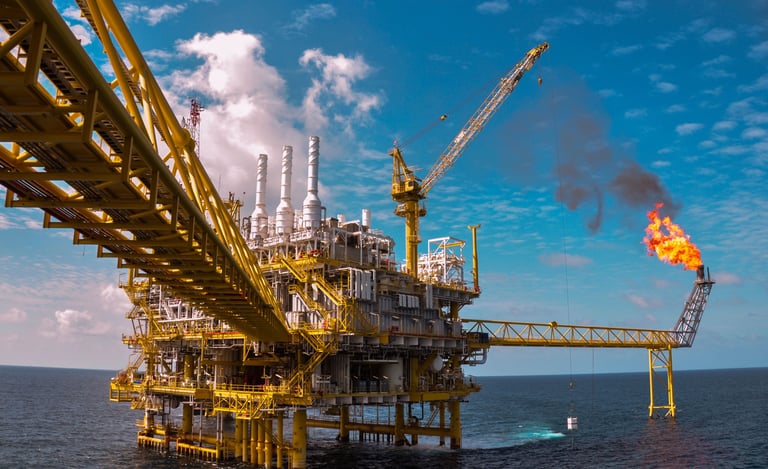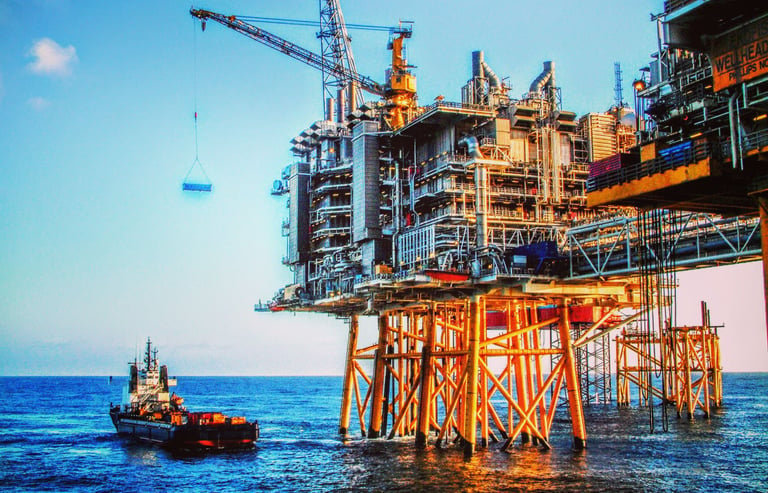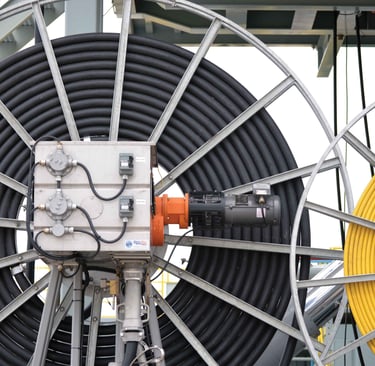📞+86 153 7530 2641 📧 hongjing.Wang@feichuncables.com

What Is a Ruggedized Cable and Why Is It Essential for Harsh Industrial Environments?
Discover what a ruggedized cable is, its key design features like abrasion resistance, UV protection, and high-flex construction, and why it's crucial in industrial, mining, military, and port crane applications. Learn how ruggedized cables differ from standard and armored cables.
hongjing.Wang@Feichun
7/18/20258 min read
Introduction: What Is a Ruggedized Cable?
A ruggedized cable represents a specialized category of electrical and data transmission cables engineered to perform reliably in the most demanding environments where standard cables would quickly fail. Unlike conventional cables designed for controlled indoor conditions, ruggedized cables are built to withstand extreme temperatures, mechanical stress, chemical exposure, and environmental hazards that would destroy ordinary wiring systems.
The fundamental difference between ruggedized cables and standard cables lies in their construction philosophy. While standard cables prioritize cost-effectiveness and basic functionality, ruggedized cables emphasize durability, longevity, and performance consistency under adverse conditions. This harsh environment cable technology incorporates multiple protective layers, specialized materials, and reinforced designs that enable operation in extreme industrial, military, and outdoor applications.
The importance of ruggedized cables becomes apparent when considering the critical nature of many applications where cable failure could result in safety hazards, operational shutdowns, or costly repairs. In environments such as offshore oil platforms, underground mining operations, or military field communications, a durable cable system isn't just preferred—it's essential for maintaining operational integrity and personnel safety.




Core Features of Ruggedized Cables
Reinforced Outer Jackets: Advanced Material Protection
The foundation of any ruggedized cable system lies in its outer jacket construction, which serves as the first line of defense against environmental threats. Modern ruggedized cables utilize advanced materials including polyurethane (PU), thermoplastic elastomers (TPE), and Low Smoke Zero Halogen (LSZH) compounds. These materials offer superior resistance to abrasion, puncture, and environmental degradation compared to standard PVC jackets.
Polyurethane jackets excel in applications requiring flexibility combined with toughness, making them ideal for robotic and mobile equipment installations. The material's inherent resistance to oils, solvents, and mechanical wear ensures long-term performance in industrial settings. TPE compounds provide excellent flexibility across wide temperature ranges while maintaining structural integrity, particularly valuable in applications involving frequent flexing or movement.
Braided or Armored Shielding Against Physical Damage
Physical protection represents another crucial aspect of ruggedized cable design. Many ruggedized cables incorporate braided metal shields or armored constructions to protect against impact, crushing forces, and rodent damage. These protective layers may include stainless steel braids, galvanized steel wire armor, or specialized synthetic materials designed to distribute mechanical stress across the cable structure.
The impact-proof outdoor cable design often features multiple protection layers, with inner braided shields providing electromagnetic interference (EMI) protection while outer armor layers defend against physical damage. This dual-layer approach ensures both signal integrity and mechanical durability in challenging environments.
Resistance to UV, Ozone, Oil, and Chemicals
Environmental resistance capabilities distinguish ruggedized cables from standard alternatives. UV resistance prevents degradation from prolonged sun exposure, crucial for outdoor installations where cables may be exposed to direct sunlight for years. Ozone resistance protects against atmospheric ozone, which can cause cracking and premature aging in standard cable materials.
Chemical resistance becomes particularly important in industrial environments where cables may encounter oils, solvents, acids, or other corrosive substances. Ruggedized cables designed for chemical processing plants or offshore installations often feature specialized jacket materials that resist specific chemical threats while maintaining flexibility and electrical performance.
Wide Operating Temperature Range Performance
High-temperature cable performance represents a critical specification for ruggedized applications. Many ruggedized cables operate effectively across temperature ranges from -40°C to +125°C, significantly exceeding the capabilities of standard cables. This temperature resilience ensures consistent performance in extreme climates, from Arctic installations to desert environments or high-temperature industrial processes.
The wide temperature range capability results from careful selection of conductor materials, insulation compounds, and jacket materials that maintain their properties across temperature extremes. Specialized formulations prevent brittleness at low temperatures while resisting softening and degradation at high temperatures.
High-Flex and Torsion-Resistant Constructions
For applications involving continuous motion, ruggedized cables feature specialized constructions designed to withstand millions of flex cycles without failure. These flexible ruggedized cables incorporate fine-stranded conductors, specialized insulation materials, and optimized lay patterns that distribute mechanical stress during flexing operations.
Torsion-resistant cable for mobile systems represents an advanced category where cables must withstand both flexing and twisting motions simultaneously. Robotic applications, cable chains, and rotating equipment require cables that maintain electrical continuity and mechanical integrity through complex motion patterns over extended periods.


Application Scenarios Across Industries
Military: Tactical Field Communication Systems
Military applications demand the highest levels of reliability and durability from cable systems. Military-grade cables used in tactical field communication must withstand combat conditions, extreme weather, and rapid deployment scenarios. Rugged fiber optic cables enable secure, high-bandwidth communications in forward operating bases and mobile command centers.
Field deployable rugged cables for military applications often incorporate quick-connect systems, allowing rapid setup and teardown of communication networks. These cables must meet stringent military specifications for electromagnetic interference resistance, physical durability, and environmental performance across global deployment scenarios.
Mining: Abrasion-Resistant Control and Power Systems
Mining operations present some of the most challenging environments for cable systems. Underground mines subject cables to constant abrasion from rock, dust, moisture, and mechanical equipment. Ruggedized cable for mining applications features enhanced abrasion resistance, often incorporating multiple protective layers and specialized materials designed to withstand the harsh underground environment.
Surface mining operations require cables that resist UV degradation, temperature extremes, and chemical exposure from processing operations. Power cables for mining equipment must maintain electrical performance while withstanding constant vibration, impact, and flexing as equipment moves through mining sites.
Oil & Gas: Chemical and Saltwater Resistance
Offshore oil platforms and onshore refineries expose cables to some of the most corrosive environments imaginable. Ruggedized cable for oil platforms must resist saltwater corrosion, hydrocarbon exposure, and extreme weather conditions. These installations require cables that maintain performance for decades without replacement, given the high cost and complexity of offshore maintenance operations.
Subsea applications demand even higher levels of protection, with cables requiring specialized designs to withstand water pressure, marine growth, and constant exposure to seawater. The ruggedized construction must protect both power and data transmission capabilities while maintaining long-term reliability in these harsh marine environments.
Railway and Transportation: Shock and EMI Resistance
Railway applications subject cables to constant vibration, shock, and electromagnetic interference from traction motors and electrical systems. Signal cables must maintain data integrity despite these challenging conditions, requiring specialized shielding and construction techniques. Transportation systems also demand fire-resistant materials to meet safety regulations for passenger and cargo applications.
Rolling stock applications require cables that withstand constant flexing as trains navigate curves and track irregularities. The ruggedized construction must maintain electrical performance through millions of flex cycles while resisting environmental contamination from outdoor exposure.
Broadcasting and Outdoor Events: Portable Rugged Solutions
Outdoor broadcasting and event production require cables that combine ruggedized construction with portability and ease of deployment. These applications demand cables that resist weather exposure, mechanical abuse from frequent setup and teardown, and electromagnetic interference from nearby equipment.
Portable ruggedized cables for broadcasting often incorporate lightweight materials and flexible designs that facilitate rapid deployment while maintaining professional-grade performance standards. The construction must balance durability with handling characteristics suitable for field production environments.
Compliance with Industry Standards
MIL-STD-810: Military Durability Testing
The MIL-STD-810 standard represents the gold standard for military rugged cable testing, encompassing comprehensive environmental and durability testing protocols. This military specification evaluates cable performance under extreme temperature cycling, humidity exposure, vibration, shock, and other environmental stresses that military equipment may encounter during deployment.
Cables meeting MIL-STD-810 requirements undergo rigorous testing that simulates real-world military environments, ensuring reliable performance in combat and peacekeeping operations. The standard covers everything from arctic conditions to tropical environments, providing confidence that military-grade cables will perform when needed most.
EN 50289-3: Mechanical Performance Standards
The EN 50289-3 cable testing standard focuses specifically on mechanical performance characteristics of communication cables. This European standard evaluates cables under various mechanical stress conditions, including tensile strength, impact resistance, and crush resistance. The standard ensures that cables maintain electrical performance even when subjected to significant mechanical stress.
EN 50289-3 testing provides manufacturers and users with standardized metrics for comparing cable performance across different products and applications. The standard's comprehensive testing protocols help ensure that ruggedized cables meet performance expectations in demanding industrial applications.
UL 758 / UL 2277: Safety and Performance Compliance
UL cable standards provide critical safety and performance benchmarks for electrical cables used in North American markets. UL 758 covers appliance wiring materials, while UL 2277 addresses flexible motor and control cables. These standards ensure that ruggedized cables meet essential safety requirements for electrical installations while maintaining performance characteristics suitable for industrial applications.
Compliance with UL standards provides assurance that cables meet fire resistance, electrical performance, and mechanical durability requirements established by Underwriters Laboratories. This compliance is often mandatory for electrical installations in commercial and industrial facilities.
Ruggedized vs Armored Cables: What's the Difference?
The distinction between ruggedized and armored cables represents a common source of confusion in the cable industry. While these terms are sometimes used interchangeably, they actually describe different aspects of cable construction and protection. Understanding the difference between armored cable vs ruggedized cable helps users select the most appropriate solution for their specific applications.
Armored cables specifically feature metallic protection layers, typically steel wire or tape, designed to protect against mechanical damage such as crushing, impact, or rodent attacks. The armor provides excellent protection against physical threats but may not address other environmental challenges such as chemical exposure, UV degradation, or extreme temperature performance.
Ruggedized cables encompass a broader range of protective features that may or may not include metallic armor. A ruggedized cable without armor might feature enhanced chemical resistance, UV protection, and temperature performance through specialized materials and construction techniques. The ruggedization approach addresses the complete range of environmental threats that cables may encounter in challenging applications.
The choice between ruggedized, armored, or combined solutions depends on the specific threats present in each application. Underground installations may benefit from armored construction to protect against digging damage, while outdoor telecom installations might prioritize UV resistance and temperature performance over physical armor. Many applications require both approaches, resulting in ruggedized cables that also incorporate armored construction for comprehensive protection.
Chemical resistance versus impact resistance represents another important consideration when selecting cable protection strategies. Industrial chemical processing environments may require ruggedized cables with specialized chemical-resistant materials, while mechanical equipment applications might prioritize impact-resistant armored construction. The most demanding applications often require both protective approaches.
Conclusion: Why Ruggedized Cables Are a Smart Investment
The investment in ruggedized cable technology represents a strategic decision that pays dividends through improved reliability, reduced maintenance costs, and enhanced safety in challenging environments. Long-life cables designed for harsh conditions typically outlast standard cables by factors of three to five, providing significant cost savings over the system lifecycle.
Industrial cable reliability becomes particularly important in critical applications where cable failure could result in production shutdowns, safety hazards, or costly repairs. The higher initial cost of ruggedized cables often pays for itself through reduced downtime, lower maintenance requirements, and extended service life. This economic advantage becomes even more pronounced in remote or hazardous locations where cable replacement involves significant costs and safety risks.
Futureproofing represents another significant advantage of ruggedized cable technology. As industrial environments become increasingly demanding and equipment becomes more sophisticated, the robust construction of ruggedized cables provides margin for future applications and operating conditions. This forward-thinking approach helps ensure that cable infrastructure can support evolving operational requirements without premature replacement.
The comprehensive protection offered by ruggedized cables also contributes to overall system reliability and safety. By addressing multiple environmental threats simultaneously, these cables help prevent the cascading failures that can occur when standard cables fail under stress. This reliability becomes particularly valuable in safety-critical applications where cable failure could endanger personnel or equipment.
Frequently Asked Questions
What is the difference between armored and ruggedized cables? Armored cables specifically feature metallic protection layers like steel wire or tape designed to protect against mechanical damage. Ruggedized cables encompass a broader range of protective features including chemical resistance, UV protection, and temperature performance, which may or may not include metallic armor. Many ruggedized cables combine both approaches for comprehensive protection.
Can ruggedized cables be used for outdoor telecom? Yes, ruggedized cables are ideal for outdoor telecom applications. They offer UV resistance to prevent degradation from sun exposure, moisture resistance for weather protection, and temperature stability for performance across seasonal variations. Many outdoor telecom installations specifically require ruggedized cables to ensure long-term reliability in harsh environmental conditions.
What materials are used for rugged cable jackets? Common materials for rugged cable jackets include polyurethane (PU) for flexibility and chemical resistance, thermoplastic elastomers (TPE) for wide temperature range performance, and Low Smoke Zero Halogen (LSZH) compounds for fire safety applications. These materials offer superior performance compared to standard PVC jackets, providing enhanced durability and environmental resistance.
How to Reach Us
Get in Touch
SiteMap
Product Catalogue
Reeling Cable
Festoon Cable
Shore Power Cable




Scan to add us on WeChat
